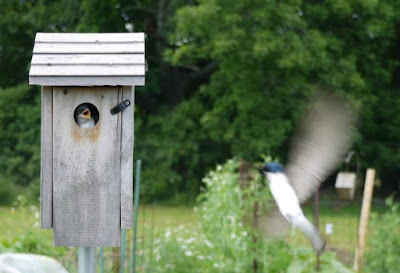| See the coyote looking for rodents after the field was hayed? (click to enlarge) |
| Community Garden |
 |
| Hiking trail |
 |
| Wetlands in the wooded area improve water quality |
 |
| Monarch butterfly caterpiller on Butterfly Weed, a type of milkweed. |
 |
| Tree Swallows nesting (successfully) in a garden plot. |
 |
| Black Swallowtail Butterfly caterpillars love dill planted by the gardeners |
 |
| There are always rabbits in the hayfield. |
 |
| Tree Swallow (left), Bluebird (right), and bluebird house. |
 |
| Bluebird eggs |
 |
| Box turtle digging holes around the community garden to lay her eggs |
| Deer. It's not uncommon to see a dozen of them at a time in the hayfield just beyond the garden. |
Another very commonly seen animal at the garden are turkeys. The gardeners and hikers often hear them gobbling in the spring. They are surprisingly tame, with turkey families often strolling about the meadow just on the other side of the deer fence from the gardeners working in their plots.
Snakes may not be everyone's favorite, but we've got those, too. When did a little Garter Snake ever hurt anyone? The worst they can do is pee on you when you pick them up.
| Turkey are seen and heard very frequently. |
| Garden snake sunning on the garden drive in early spring. |


